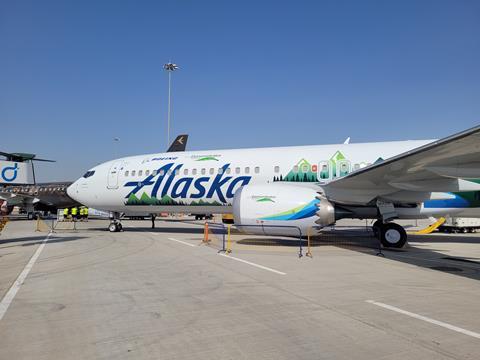The US Federal Aviation Administration has ordered the “temporary” grounding of “certain” Boeing 737 Max 9 aircraft after an incident in which a window and parts of the fuselage were blown out of an Alaska Airlines aircraft while in flight.
“The FAA is requiring immediate inspections of certain Boeing 737 Max 9 planes before they can return to flight,” FAA Administrator Mike Whitaker said on 6 January. “Safety will continue to drive our decision-making as we assist the NTSB’s investigation into Alaska Airlines flight 1282.”
The US regulator says that an Emergency Airworthiness Directive (EAD) will be issued “shortly”. It will require operators to inspect aircraft “before further flight that do not meet the inspection cycles specified in the EAD”.

The required inspections will affect about 171 aircraft and take 4-8h per airframe, the FAA says.
Boeing did not immediately respond to a request for comment on the grounding.
The move comes a day after an incident left a gaping hole in the side of an Alaska Airlines Max 9 on 5 January. The aircraft suffered a “pressurisation issue” after a window and parts of the fuselage blew out shortly after take-off from Portland, Oregon.
The incident occurred as the aircraft (N704AL) departed as flight 1282 bound for Ontario, California.
The aircraft had been climbing to 15,000ft when pilots contacted Seattle controllers for clearance to a higher altitude. But just 2min later one of the pilots transmitted an urgent request, stating: “We’d like to go down.”
The pilot followed up by declaring an emergency and saying that the aircraft was descending to 10,000ft – a standard procedure during cabin depressurisation.
Dramatic video posted online showed a hole in the fuselage, with reports that the window seat and other items had been sucked out.
The National Transportation Safety Board (NTSB) has sent a “go team” to Portland to investigate the incident. The team will arrive today and consists of board chair Jennifer Homendy and “experts in structures, operations and systems”, the safety investigatory agency adds. It says the team will likely provide an on-scene briefing after arriving.
Alaska has a fleet of 65 Max 9s in service, with another 27 examples on order. It said in a 6 January social media post that about one-fourth of the in-service Max 9 fleet had been inspected overnight and cleared to fly.
”As of this morning, inspections on more than a quarter of our 737-9 fleet are complete with no concerning findings,” the carrier posted on X, the social media platform formerly known as Twitter. ”Aircraft will return to service as their inspections are completed with our full confidence.”
The airline also has a sole Max 8 in service, as well as commitments for nine Max 8s and 43 Max 10s.
Airlines globally operate 215 Max 9s, according to Cirium fleets data. United Airlines has the largest fleet, with 79 of the jets in service. Other sizeable operators include Copa Airlines, with 29 Max 9s, and Aeromexico, with a 19-strong fleet, data shows.
Neither Copa nor United immediately responded to requests for comment.














































